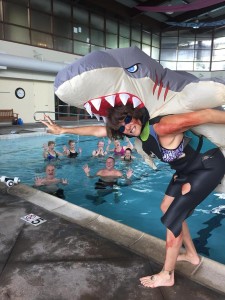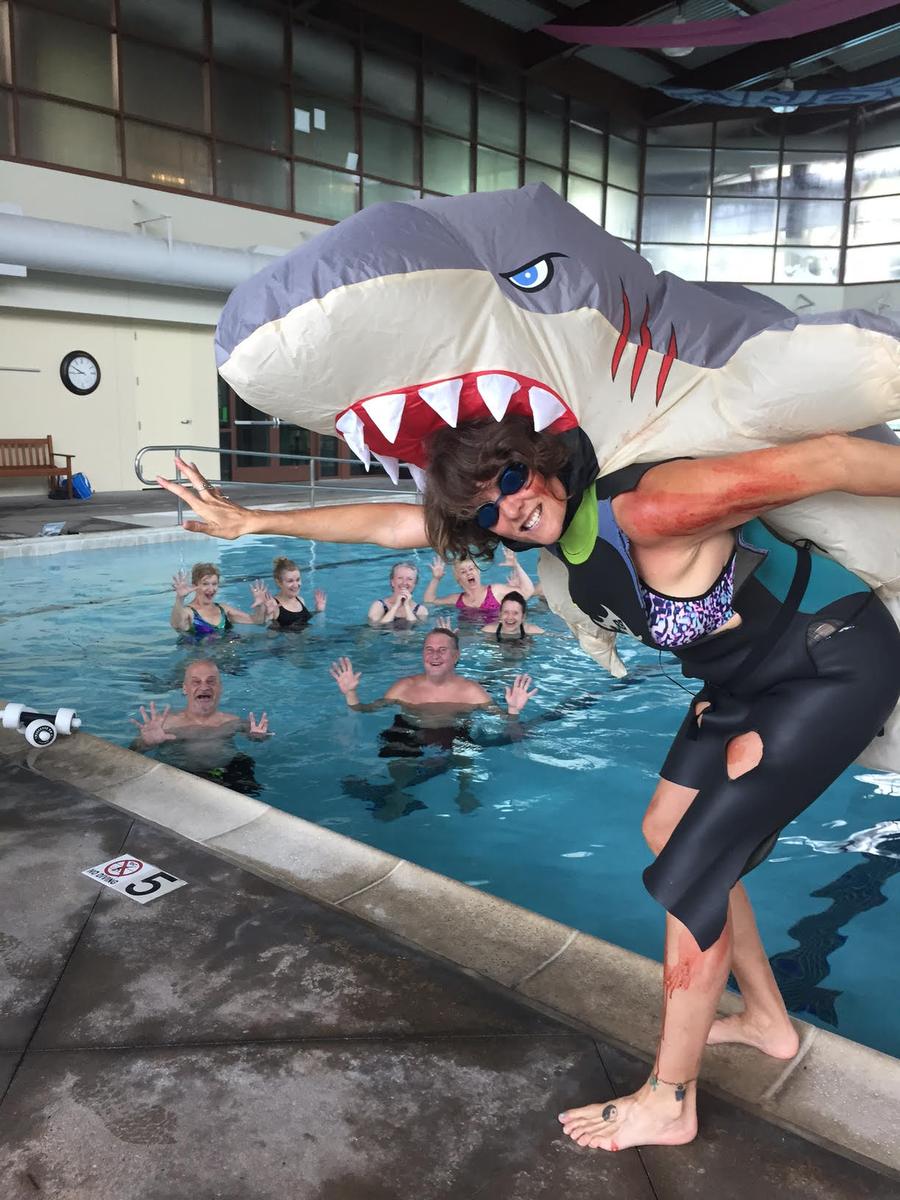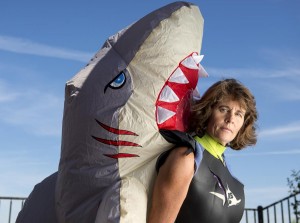
Just talking about getting in the water with sharks makes Maria Korcsmaros’ heart race.
Her 16-year-old son, Sam, always has wanted to swim with sharks. And the mother-son duo have been inseparable of late, Sam swimming with her in races and helping during her physical therapy.
But joining Sam on a shark swimming expedition – something he’s interested in doing – is where Korcsmaros draws the line.
RELATED: O.C. shark bite victim: ‘I felt the bite and the teeth going into me’
“I’m a little, um, nervous,” she said of her son’s fascination with sharks.
“But … if he learns the right techniques, and he’s diligent about his safety, there are ways to keep yourself from being attacked.”
Fear, it turns out, isn’t the same as lack of interest.
In May, Korcsmaros nearly died when a shark chewed into her side and ribs and liver as she swam off the coast of Corona del Mar.
Now she’s fighting to save them.
BOTH ARMS, LEGS
Korcsmaros runs off several big-picture things she’s thankful for this holiday weekend: family. Strength and athletic ability. Being alive.
But the competitive triathlete, who was training for an Ironman competition when she was attacked over Memorial Day weekend, gets into specifics, too.
“I’m thankful he didn’t take an arm or leg.”
She said this while walking in the parking lot outside Orange County Global Medical Center, the Santa Ana emergency hospital where she was taken when it was not at all clear she would survive.
Having her limbs, she said, has made it much easier to recover and return to “the things I love to do.”
Last month, Korcsmaros attended the Newport Beach annual lifeguard appreciation dinner, personally thanking the two lifeguards who plucked her from the ocean when they noticed the water turning red with blood. She also thanked the ambulance crew that kept her heart beating as it raced her to the hospital.
“When I got there, I had a moment of emotion because they saved my life,” she said. “To present the lifesaving award, it hit me that I was that person. I got a little teary-eyed.”
Though it was, technically, a reunion, Korcsmaros said it felt like she was meeting the people who saved her for the first time.
“So much was going on in the ambulance,” she said. “I remember people peering over me and doing stuff.”
She recalls, during the ambulance trip, asking an emergency worker to turn off the tracker she wore on her wrist, the one that tracked the length of her training swim.
Despite losing a liter of blood, her ribs broken, liver pierced and bite marks riddling her body, she still wanted to make sure her training was logged.
“We’re a little busy,” the paramedic responded.
“That’s how obsessed we are,” Korcsmaros said of competitive athletes like her.
ONE RACE AT A TIME
Korcsmaros made sure she wasn’t alone.
At the TriLa Vie Triathlon race at Mission Bay in San Diego, she swam with the “survivor” group, mostly cancer survivors. It was October, and she’d been training for the comeback race for months. The bodies formed a buffer of sorts.
“I was a little nervous in the beginning; some of it was race jitters,” she said. “I was in the middle of the pack. That assured me I would have a lot of people around me. That made me more comfortable.”
It seems swimming in saltwater, even if it’s a bay, isn’t easy after a shark bites into you.
As Korcsmaros hit the water, her competitive spirit took over. The 53-year-old’s 500-meter swim time was 17 minutes, much faster than she imagined.
When she hopped on the bike, she was breathless but managed to ride 15 kilometers at a pace of 14 mph, not as fast her old Ironman time or as fast as she has gone in countless other triathlons over the years but about the same time as an amateur triathlete.
Not bad for someone whose body was mangled just 41/2 months earlier.
The 5K run was tough; her ribs were aching. But she kept a strong pace – about 11:40 per mile, better than she thought.
Her result: an age group top 10.
“That was one of my … goals coming out of this,” she said.
“Mentally, it helped me think I was accomplishing things.”
But physically it was a reminder that just months earlier, Korcsmaros had been in a shark’s mouth.
“I’ve realized my ribs aren’t quite healed.”
‘YOU TASTE BAD’
It feels like it’s popping out.
Korcsmaros points the spot – right in front of her rib cage, just under her chest – where the pain remains intense, six months into her recovery.
The bite marks around her body – up her right shoulder, along her triceps, down her back, around to her buttocks and up her hip – mostly have healed.
But a look at X-rays shows that some damage remains: One rib is completely split in half, and another is still damaged.
Her physician, Dr. Christopher Lane, wants to see how the bones heal naturally rather than going in to try to repair them.
“We could end up with you having more problems,” he said. “Incisions, numbness, scar tissue. Those are new cuts into you. There’s always a chance we can end up with more problems trying to make you feel a little better. I don’t think we should go rushing into anything.”
She wants to beat her old times and return to the elite racer she once was.
But Lane asks this: Would that make it worth going through another surgery, just to get a better time during races?
The doctor’s appointment is lighthearted, much different from her early days there in the operating room. Lane jokes about how the shark didn’t seem to like Korcsmaros.
“Evidently, you taste bad,” he said. “It spit you out. That’s kind of insulting. You’re too muscly.”
FULL CIRCLE
Last month, Korcsmaros and her family took a road trip to Vegas. They weren’t going for the blackjack or the slots – they were going for a gathering called “Sharktoberfest.”
Korcsmaros, the woman who nearly died from a shark bite, wants to make sure sharks don’t disappear from the planet.
She was in Las Vegas to learn from marine biologist and shark expert David McGuire, founder of the Ocean Health and Shark Conservation nonprofit Shark Stewards. McGuire, who gives lectures on shark diving and the latest shark laws, urged advocates to do what they can to stop the worldwide trade of shark fins, the key ingredient in shark fin soup, a delicacy in some cultures.
Korcsmaros felt drawn to the cause. During the weekend, she handed out posters and asked customers to sign a petition to back a bill for more shark protection.
“Shark fin soup, they pick any shark they want. They don’t discriminate between babies or adults. They throw it back, and it’s just left to die,” she said. “A shark can’t swim if it has no fin. That’s just cruelty to animals.
“Just because a shark bit me,” she added, “I don’t think a shark should die for shark fin soup.”
Korcsmaros said she wants to learn more about sharks – how to keep herself safe if she gets back into the open ocean and how to keep her son safe if he wants to dive with sharks.
“Wildlife is unpredictable, so putting yourself in a situation like that, you have to be aware of what you’re doing and the risk.”
She won’t be signing up for a shark diving trip any time in the near future.
“Just thinking about it,” she added, “my heart is taking a leap.”
Still, she has traveled far in her recovery, not just physically but mentally.
In June, when TV’s “Shark Week” was on, just seeing the promotional commercials left Korcsmaros spooked.
Last month, for Halloween, she dressed up as a shark.
She wears a constant reminder around her neck, a necklace made out of 161 surgical staples that pulled together the flesh that a shark once had ripped apart.
She has a few new goals now that she’s faced death.
“My goal moving forward is to have fun into my 50s, 60s and 70s and beyond,” she said. “And try and let the little things go and concentrate on the big picture, and enjoying life one day at a time.
“You never know when it’s going to be taken away.”
Contact the writer: lconnelly@scng.com








